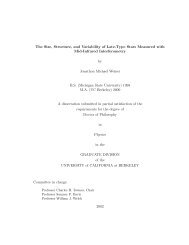Problem #1 [Structure Formation I: Radiation Era]
Problem #1 [Structure Formation I: Radiation Era]
Problem #1 [Structure Formation I: Radiation Era]
You also want an ePaper? Increase the reach of your titles
YUMPU automatically turns print PDFs into web optimized ePapers that Google loves.
For the present horizon size we must set z = 0 into the above expressions. For Ω m = 0.3 we use<br />
[<br />
]<br />
c<br />
d H (z = 0) = √ cosh −1 2(1 − 0.3)<br />
1 + = 8.7 Gpch −1<br />
H 0 1 − 0.3 0.3<br />
For Ω m = 1 we use<br />
For Ω m = 3 we use<br />
d H (z = 0) =<br />
d H (z = 0) = 2c<br />
H 0<br />
= 6.0 Gpch −1<br />
[<br />
c<br />
√ cos −1 1 −<br />
H 0 3 − 1<br />
]<br />
2(3 − 1)<br />
= 4.0 Gpch −1<br />
3<br />
(c). Show that at high redshifts 1 + z ≫ Ω −1<br />
0,m<br />
, a good approximation for all three cases is given<br />
by<br />
2c<br />
d H (z) ≈ √ (1 + z) −3/2<br />
Ω0,m H 0<br />
(you may find the identity cosh −1 x = ln(x + √ x 2 − 1) useful.)<br />
For Ω 0,m < 1 we will use<br />
d H (z) =<br />
c<br />
H 0<br />
√<br />
1 − Ω0,m<br />
(1 + z) −1 cosh −1 (1 + α)<br />
where α = 2(1 − Ω 0,m)<br />
(1 + z)Ω 0,m<br />
using the above relationship for cosh −1 we find<br />
√<br />
cosh −1 (1 + α) = ln[1 + α + (1 + α) 2 − 1] = ln[1 + α + √ 2α]<br />
but we know that<br />
√<br />
2α > α<br />
and we can just write<br />
and we know that the Taylor expension for<br />
so we now get<br />
so now the distance horizon becomes<br />
d H (z) ≈<br />
cosh −1 (1 + α) = ln[1 + √ 2α]<br />
ln(1 + x) ≈ x<br />
cosh −1 (1 + α) ≈ √ 2α<br />
c<br />
H 0<br />
√<br />
1 − Ω0,m<br />
(1 + z) −1√ 2α ≈<br />
6<br />
2c<br />
√<br />
Ω0,m H 0<br />
(1 + z) −3/2


![Problem #1 [Structure Formation I: Radiation Era]](https://img.yumpu.com/37147371/6/500x640/problem-1-structure-formation-i-radiation-era.jpg)













